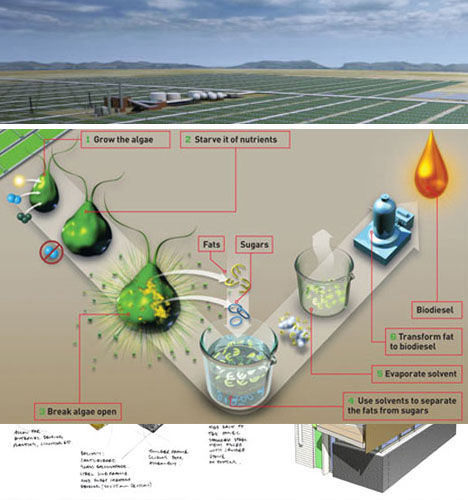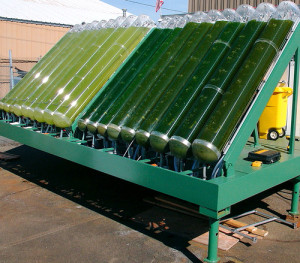This post is written by guest blogger Beth Kelly, a Midwestern freelance writer with a passion for sci-fi and analog photography, as well as all kinds of other outdated and obsolete technology. She graduated from DePaul University with a degree in Art History and Communications in 2011. She collects Soviet-era memorabilia and vintage silent movie posters. Find her on Twitter @bkelly_88
Algae in any form of industrial production conjures up thoughts of Soylent Green, the 1973 sci-fi film that paints a bleak picture of life in the year 2022. Set in a futurist New York dystopia, the world is beset by overpopulation, resource scarcity, and the effects of rampant global warming. In this unfortunate era mankind has become entirely dependent upon a green food ration (supposedly) made from high-energy plankton from the oceans. This, of course, is not the true nature of Soylent, but as it turns it out, the film’s scientists may have been on to something after all.
Algae, a form of plankton, feed fish and animals, and is also used as a food additive and nutritional supplement. One day it may even be used as a food source for interplanetary colonists. But perhaps most significantly, it can be put to use as a homegrown source of power. Microalgae convert sunlight to energy that some algae strains store in the form of oil. The natural oils or lipids can be harvested, extracted, and further processed into biofuels for cars, trucks, trains, and planes to lessen dependence on foreign oil, increase energy security, and decrease the effects of climate change.

Since algae farms cultivate new crops every few weeks, microalgae have the capability to produce 60 times more oil per acre than land plants. The lipids are harvested, extracted and further processed into biofuel at an integrated biorefinery. Since microalgae need CO2 to grow, algae can be a nearly carbon-neutral fuel source. Algae also don’t occupy agricultural resources that are stressed by population growth and climate change as do food-based biofuels. In contrast to corn ethanol, algae can be grown in environments such as man-made ponds, brackish water, and wastewater.
Just as Soylent Green’s Exchange leaders demand proof of the algae-as-food theory, in proof-of-principle demonstrations algae systems have successfully powered buildings, jet planes and shuttle buses. Hamburg, Germany boasts the world’s first algae-powered apartment building, whose heating and cooling run on louvered tanks of algae on the exterior. In 2009, Continental Airlines made the first algae-based jet fuel test flight, and in 2011, United Airlines made the first algae-powered passenger flight from Houston to Chicago. Recently in Japan, Euglena Co. and Isuzu Motors partnered to produce a fleet of eco-friendly shuttle buses that run on microalgae-based biodiesel. Not only do algae play a part in green transportation, they can also help in directly cleaning up the environment such as with Alberta Energy, a Canadian energy company that has genetically engineered new kinds of algae that help clean up oil spills.

Much of the scientific research surrounding algae as a renewable climate-neutral power source seeks to reduce the overall production costs from the benchmark $7.50/gallon to a gasoline-competitive cost of $3/gallon. Engineers are in the midst of developing ways to optimize the productivity of microalgal cultivation, and identifying various strains that possess more advantageous biofuel production traits than others.
Ultimately, for algae biofuel to be financially and environmentally sustainable, we need to make use of the by-products as well. Fortunately, algae are a valuable source of feed, nitrogen-based fertilizer, and alternative non-petroleum-based plastics. Algae can also consume nitrate-rich waste from farms and fisheries or mop up the CO2 from nearby industrial plant flue gases. Microalgae can take the carbon dioxide released by power plants and cars and turn it into oxygen. Carbon dioxide—or bicarbonate-capturing efficiencies as high as 90% have been reported in open ponds. They run on sunlight and scrub the air. Nuclear power plants, oil refineries and coal producers can take advantage of algae to help clean up waste, concentrating dispersed waste products in more easily managed forms. Recently discovered radiation-proof microalgae strains can clean wastewater.

algae farm
In Soylent Green, a careless use of the Earth’s resources has left the world polluted, permanently overcrowded, resource-starved, and hot. Food sources are in such short supply that the government has made a drastic decision – delude the general population into believing that they are eating algae when in fact they are eating one another. As we come to find out, Soylent Green is actually made from a land-based protein source: people.
Today, we see the effects of climate change due to industrialization manifested as drought, famine, high temperatures, desertification, extreme weather, and rising sea levels. Today’s world, however, unlike the world of Soylent Green, is actively seeking solutions through innovation and meeting the challenges of looming climate change.
As we strive to leverage innovations in technology, agriculture, business, industry and environment to tackle the myriad of challenges facing both our planet and its people, it is clear that algae are an unconventional alternative to fossil fuels that will help preserve the Earth and its environment.
